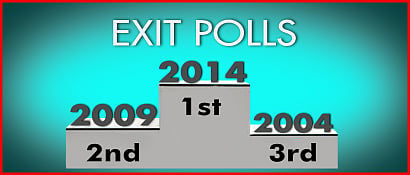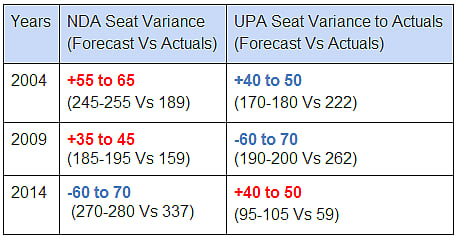Same Old Exit Polls
Comparing 2004, 2009 and 2014 exit polls. More similarities than differences?

Pollsters like Yashwant Deshmukh from CVoter are taking a victory lap on Twitter for the “big success of opinion and exit polls in India”. However, Vozag’s comparison of exit polls to actuals shows a variance of 50-60 seats depending on the pollster. How can a projection that is off by 50 to 60 seats still be counted as a victory? Is getting the winner right but missing the projected number of seats by a significant margin good enough?
Maybe pollsters are under the same pressure as weathermen to overestimate the chances of rain so people don’t curse them when they get stuck in it. As Nate Silver, the demi-god of poll forecasters pointed out in his book, The Signal and the Noise, a study of TV meteorologists in Kansas City found that when they said there was a hundred per cent chance of rain, it failed to rain at all one-third of the time.
However, in polling, isn’t it more important to be accurate than conservative in the prediction of the victor? When you are conservative on the winning side (e.g. the margin of victory for National Democratic Alliance), aren’t you being aggressive on the losing side (e.g. the number of seats that United Progressive Alliance will get)?
Let’s take a look at some data for exit poll to actual seat variances from 2004, 2009 and 2014

So, from a simple statistical variance measurement perspective, the 60 seat difference for the winner or loser and another 40 seat difference for the other side has been upheld in 2004, 2009 and 2014 as well.
